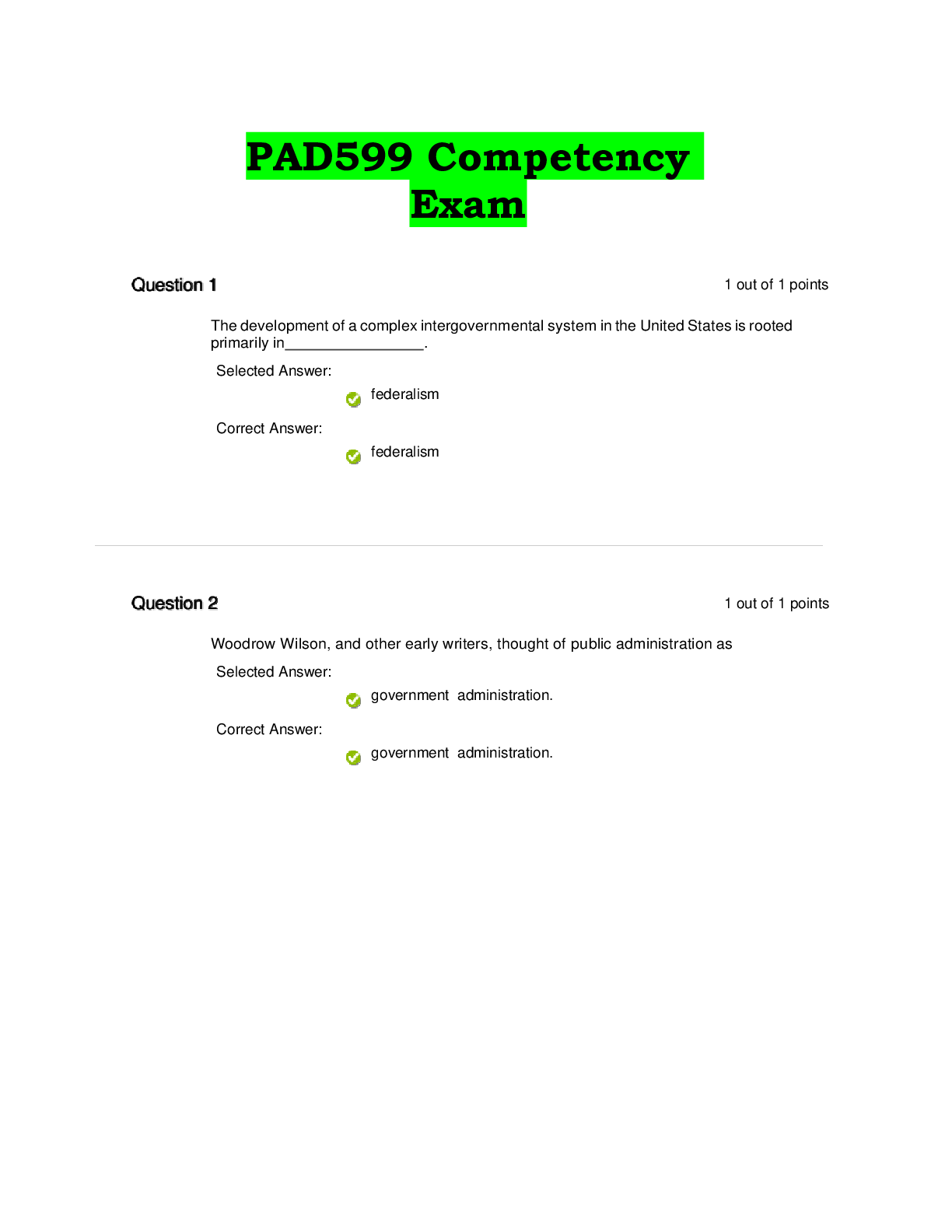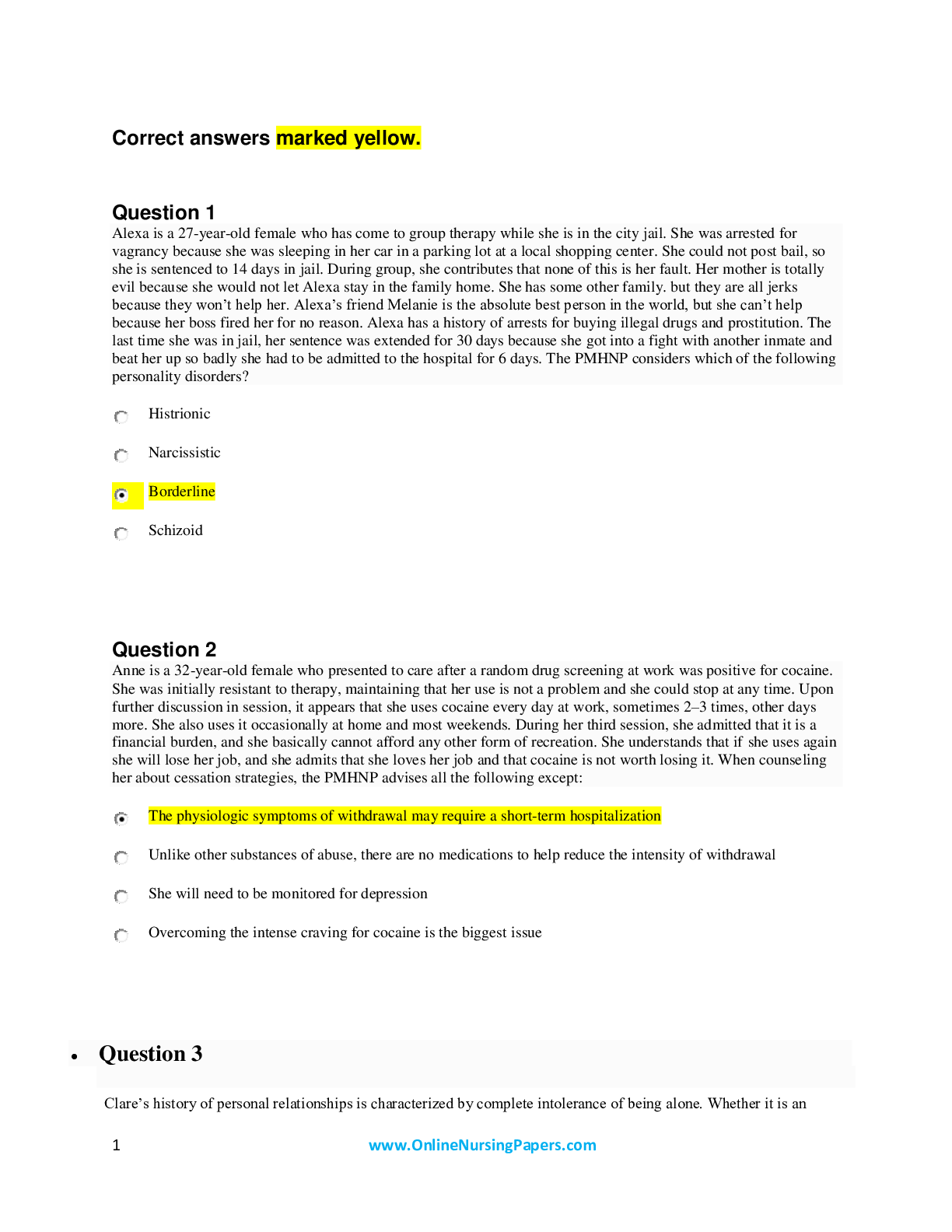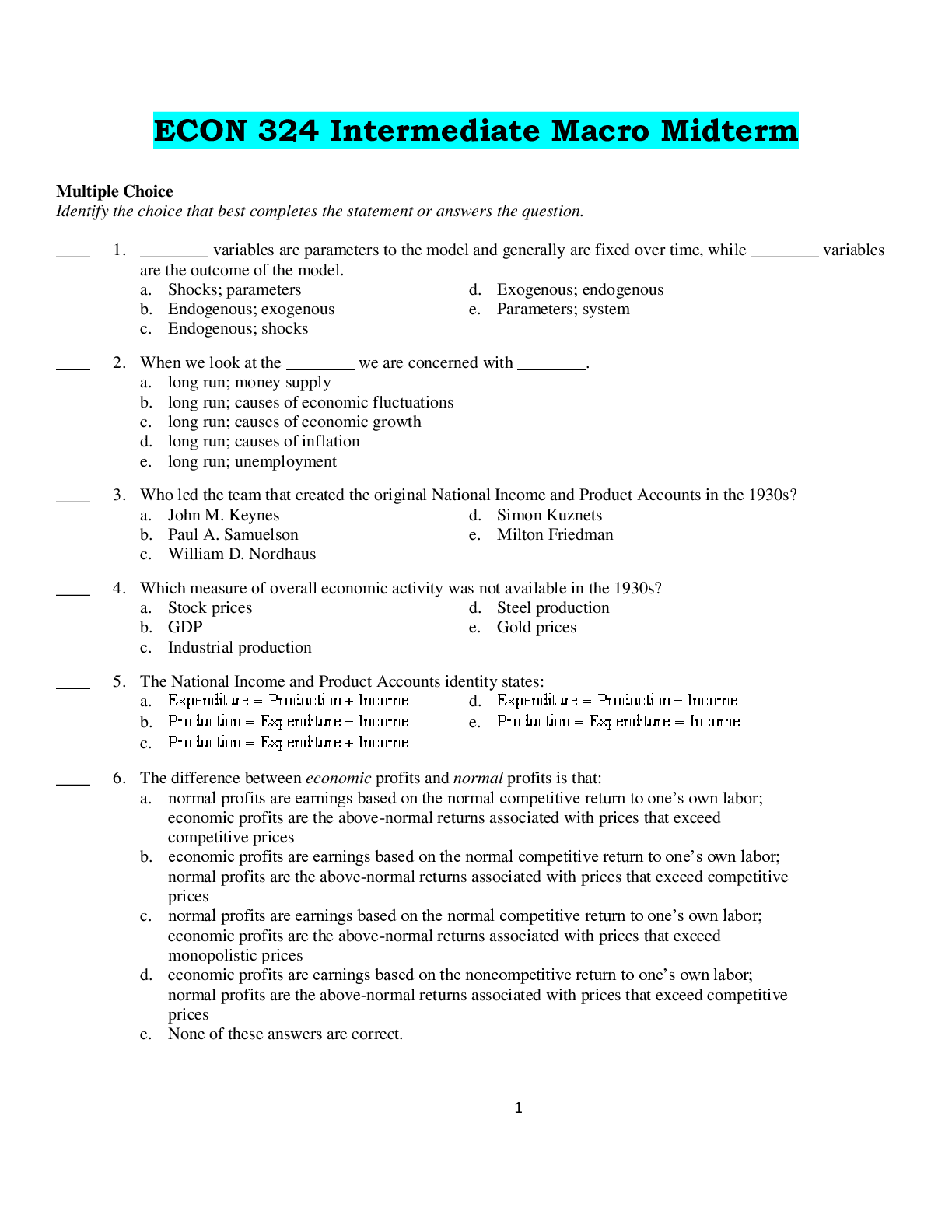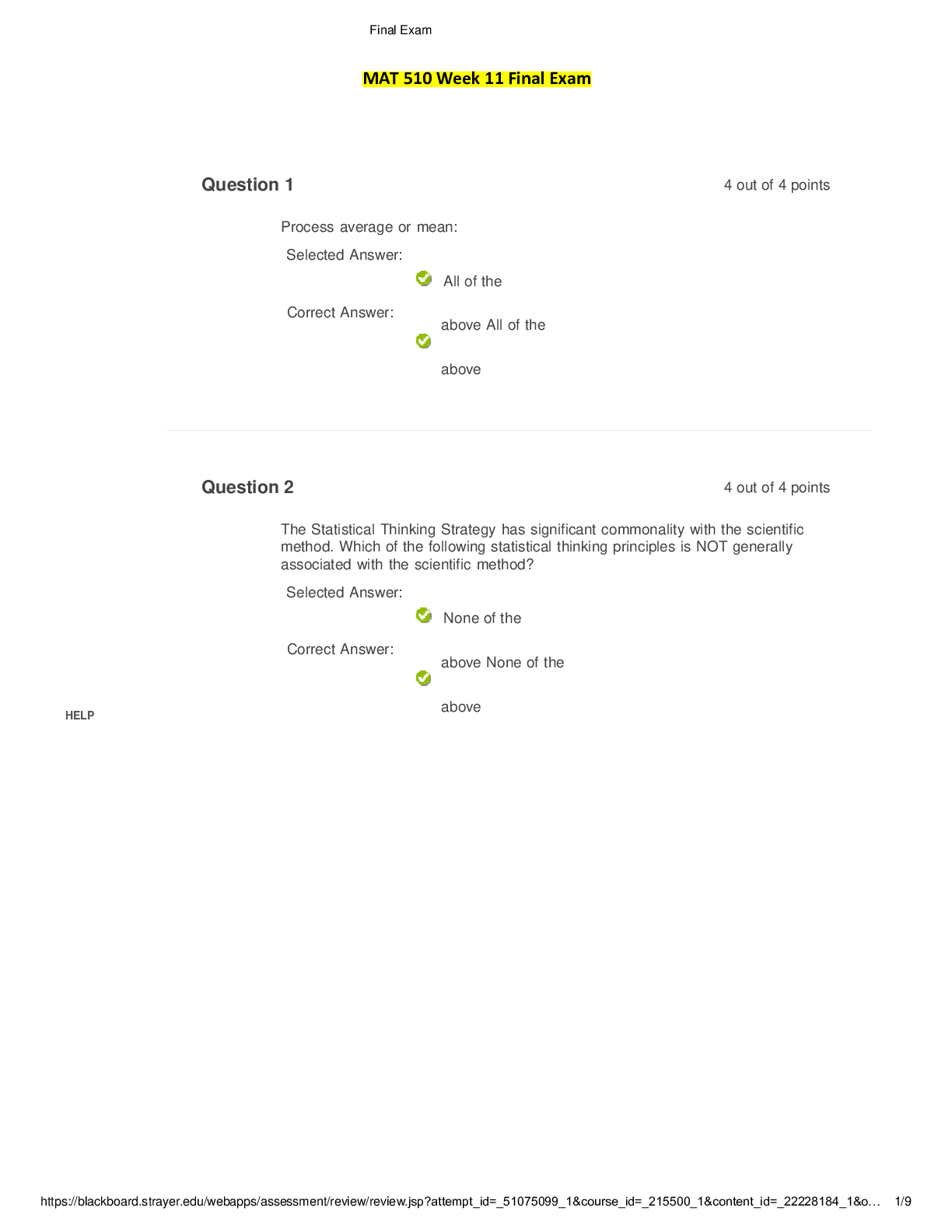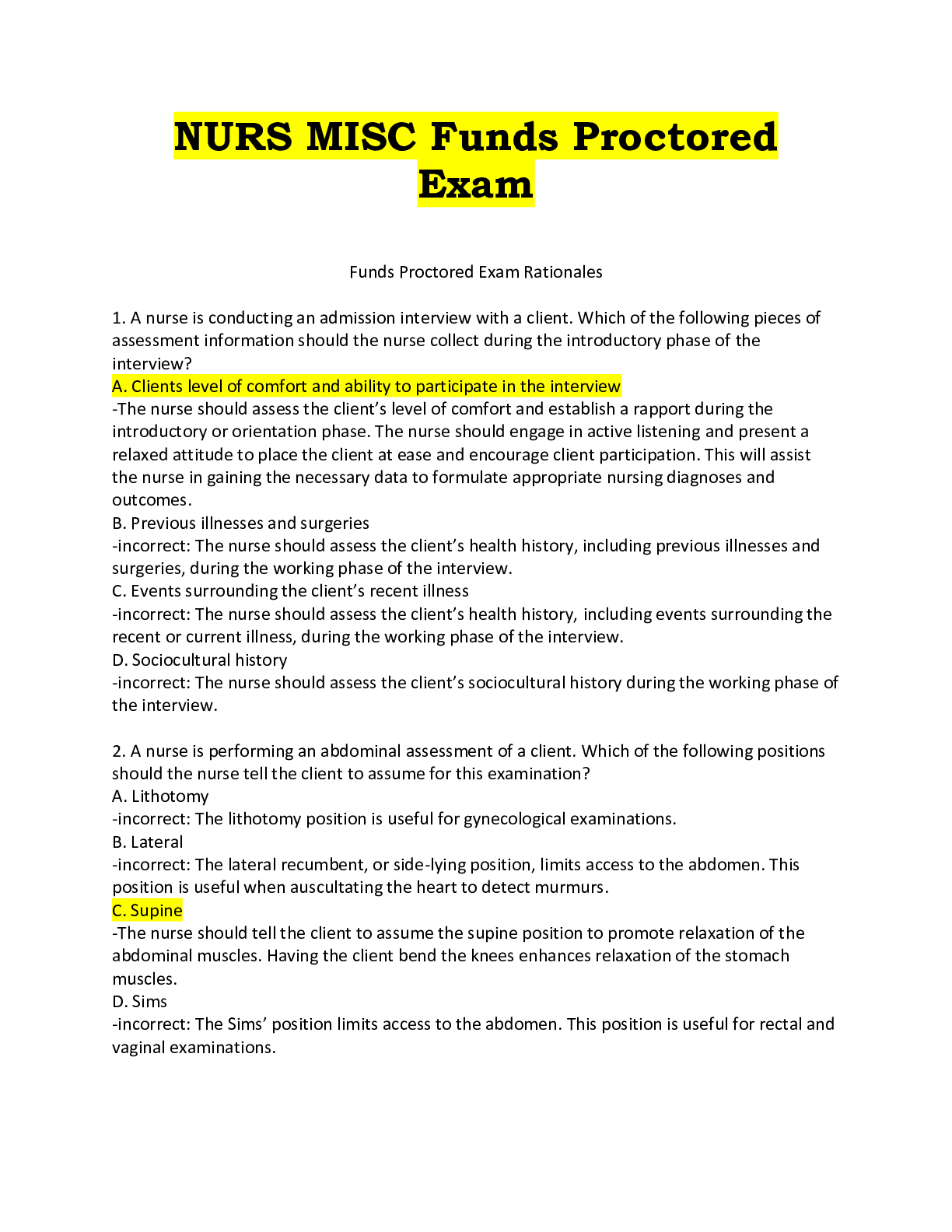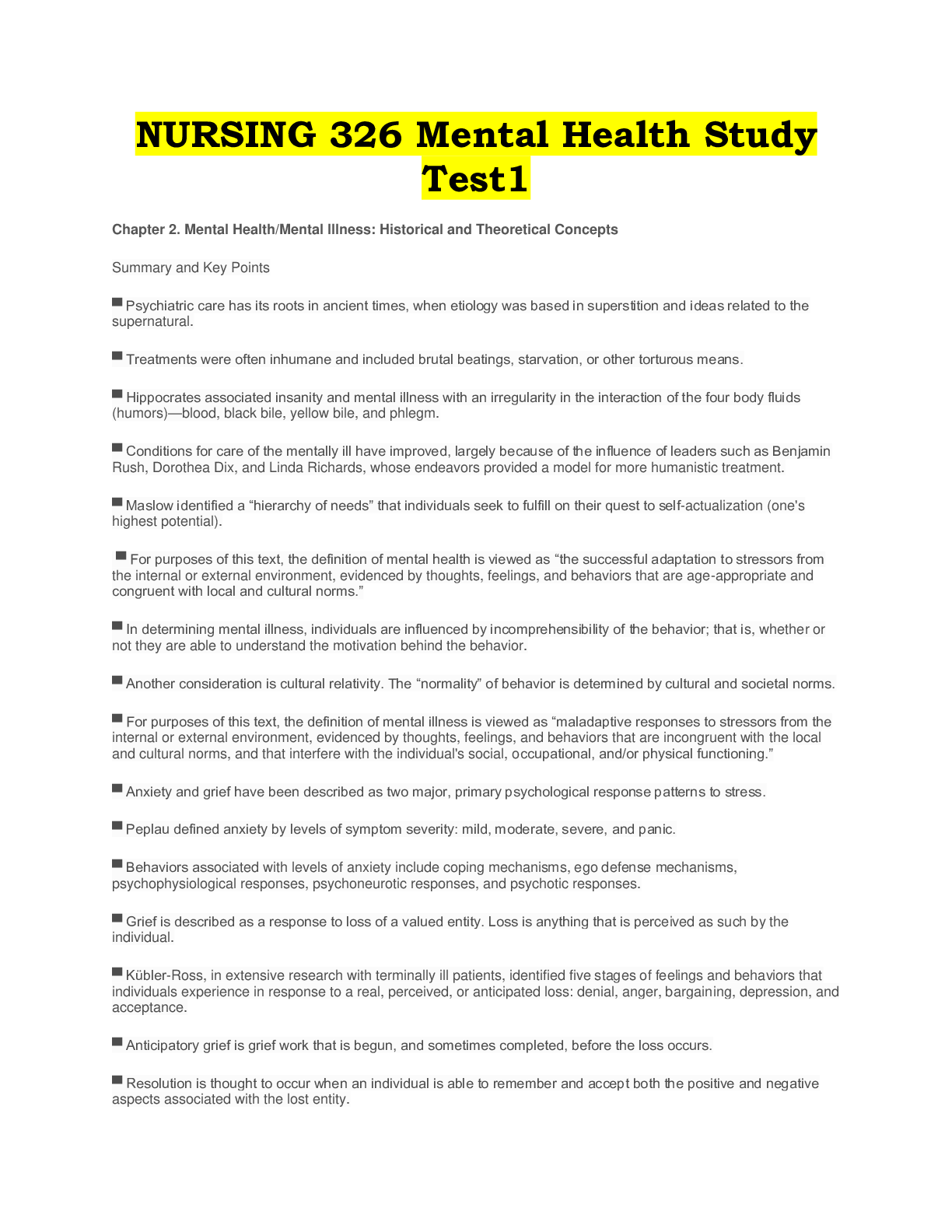Pharmacology > Final Exam Review > NURSING NR447 MOC PEDS PHARM (All)
NURSING NR447 MOC PEDS PHARM
Document Content and Description Below
1. What instruction should the nurse provide to a parent regarding the prevention of urinary tract infection in his child? A. Wrap the diaper tightly on the child B. Avoid giving the child bubble b... aths C. Use underwear made of a synthetic fabric D. Encourage the child to hold the urine to avoid frequent voiding 2. A nurse is caring for an infant with hypospadias. The nurse makes a priority of assessing the infant’s: A. Blood pressure B. Urinary output C. Level of consciousness D. Gastrointestinal function 3. A nurse is performing an assessment of a school-age child admitted with acute poststreptococcal glomerulonephritis. Which question would help determine the cause of this acute condition? A. “Have you fallen off your bicycle recently?” B. “Did you have a sore throat a few weeks ago?” C. “Have you had chickenpox in the last 2 months?” D. “Have you eaten any shrimp or crab in the last 7 to 10 days?” 4. Which laboratory result would the nurse expect to see in a child admitted to the hospital with acute glomerulonephritis? A. Hematocrit of 38% B. 2+ protein in the urine C. Serum potassium of 3.8 mg/dL D. White blood cell (WBC) count of 9800 cells/mm3 5. A nurse is performing an assessment of a child with nephrotic syndrome. Which manifestation would the nurse most likely note? A. Periorbital edema B. Weight loss of 1.5 kg C. Temperature of 99.2° F D. Blood pressure of 128/86 mm Hg 6. Which medication is essential for the nurse to have available before administering an allergy injection to a child? A. Immune globulin B. Ibuprofen C. Epinephrine D. Acetaminophen7. A nurse is providing home care instructions to the mother of a child with sinusitis. Which statement by the mother indicates a need for further instruction? A. “Tylenol can help relieve the discomfort.” B. “I need to encourage him to drink clear liquids.” C. “Breathing cool, moist air will help drain his sinuses.” D. “I can put warm, moist compresses over his sinuses to make him feel better.” 8. Which pediatric client is at least risk for otitis media? A. A breastfed infant B. A bottle-fed infant C. A child who attends a daycare center D. A child exposed to environmental smoke 9. A nurse provides home care instructions to the mother of a child who has undergone myringotomy with the insertion of tympanostomy tubes. Which statement by the mother indicates a need for further instruction? A. “A fever is normal after this procedure.” B. “I need to call the doctor if the tubes fall out.” C. “I need to keep his ears dry while he’s taking a bath.” D. “I should keep him from blowing his nose for 7 to 10 days.” 10. The mother of a child who underwent myringotomy with the insertion of tympanostomy tubes 1 day ago calls the physician’s office and reports to the nurse that the child has a small amount of reddish drainage coming from the ears. The nurse should tell the mother to: A. Irrigate the ears gently with warm water B. Bring the child to the physician’s office to be checked C. Carefully push the tubes a little farther into the ear canal D. Continue to monitor the drainage, because this is a normal finding 11. A child has been found to have pharyngitis. The most reliable method of determining whether the infection is bacterial or viral in origin is: A. Throat culture B. The rapid streptococcal antigen test C. Monitoring for complaints of a sore throat D. Collecting data regarding the child’s signs and symptoms 12. A nurse is caring for a child scheduled for a tonsillectomy. To reduce the risk of aspiration during surgery the nurse should assess the child for: A. Loose teeth B. Throat redness C. Signs of active infection D. Exudate in the tonsillar area13. A nurse is assessing a child after tonsillectomy. Which finding is indicative of postoperative bleeding? A. Slowed pulse rate B. Frequent swallowing C. Complaints of throat pain D. An increase in blood pressure 14. In which position should the nurse place the child who has just undergone tonsillectomy to facilitate drainage? A. Prone B. Supine C. High Fowler D. Semi-Fowler 15. A nurse is providing discharge dietary instructions to the mother of a child who has undergone tonsillectomy. Which of the following items should the nurse tell the mother that it is safe to give the child? Select all that apply. A. Water B. Dark toast C. Cherry gelatin D. Scrambled eggs E. Mashed potatoes 16. A nurse provides home care instructions to the parents of a child with acute spasmodic croup. The nurse should tell the parents that if stridor at rest occurs, they should: A. Administer an analgesic B. Take the child to the emergency department C. Place a cool-mist humidifier in the child’s room D. Provide mist from steam produced by hot running water in a closed bathroom 17. A nurse is admitting a child with respiratory syncytial virus (RSV) infection to the hospital. The nurse tells the parents that the best way to prevent the spread of the infection is: A. Restricting visitors B. Wearing goggles and a mask C. Washing the hands meticulously D. Wearing goggles and a protective gown 18. A nurse is monitoring a child who sustained a head injury. Which assessment finding is an early sign of increased intracranial pressure (ICP)? A. Bradycardia B. Change in behavior C. Widened pulse pressure D. Change in respiratory rate and pattern19. A nurse provides information to new parents about measures to reduce the risk of sudden infant death syndrome (SIDS). The nurse tells the parents to: A. Obtain a soft crib mattress and soft bedding B. Place the infant in a supine position for sleep C. Place the infant in a face-down position for sleep D. Be sure that the infant sleeps in a crib in the parent’s room until the age of 12 months 20. A child with severe respiratory distress is seen in the emergency department and treated for an acute asthmatic episode. Which assessment finding indicates that the child’s condition is improving? A. Stridor B. Shortness of breath C. Increased wheezing D. Dyspnea on exertion 21. A child who is experiencing wheezing during an acute asthma episode is brought to the emergency department by the parents. Which intervention does the nurse implement first? A. A chest x-ray B. Administration of a corticosteroid C. Administration of a bronchodilator D. Insertion of an intravenous (IV) catheter 22. A nurse provides instruction to an adolescent client with exercise-induced asthma. Which statement by the adolescent indicates a need for further instruction? A. “I should use the bronchodilator after I finish working out.” B. “The symptoms usually begin after 5 to 10 minutes of exercise.” C. “I should use progressive muscle-relaxation techniques to keep from hyperventilating.” D. “When I exercise in cold weather, I should warm cover my nose and mouth with a scarf to warm up the air I’m breathing.” 23. A nurse is providing instructions on the use of a metered-dose inhaler (MDI) to an adolescent with asthma. Which statements by the adolescent indicates an understanding of the instructions? Select all that apply. A. “I need to shake the inhaler well before I use it.” B. “I really need to use the spacer when I inhale the corticosteroid.” C. “After I breathe the medication in, I should hold my breath for 1 or 2 seconds.” D. “I have to put my lips tightly around the mouthpiece, press down on the inhaler, and breathe in slowly.” E. “The doctor has prescribed two inhalations, so I need to breathe in the second inhalation immediately after the first.”24. A nurse provides instructions to the parents of an infant with bronchopulmonary dysplasia about the safe use of oxygen at home. Which statement by a parent indicates a need for further instruction? A. “We need to keep the oxygen tank upright.” B. “We should have a fire extinguisher close at hand.” C. “We can put petroleum jelly on her lips to relieve the dryness.” D. “We need to keep the oxygen tank at least 5 feet from electrical devices.” 25. The nurse is assigned a child who has been admitted to the hospital with suspected cystic fibrosis (CF). Which of the following tests does the nurse anticipate will be prescribed to diagnosis CF? Select all that apply. A. Chest x-ray B. Barium swallow C. Intestinal biopsy D. Sweat chloride assay E. Stool examination for ova and parasites 26. A registered nurse (RN) on the 7 a.m.–3 p.m. shift is planning client assignments for the day. Which of the following clients would be appropriate for the RN to assign to the licensed practical nurse (LPN)? Select all that apply. A. A client who had a mastectomy 2 days ago B. A client with type 1 diabetes mellitus who has a foot ulcer C. A client with left-side weakness who will need assistance with personal care D. A newly admitted client with chronic obstructive pulmonary disease (COPD) E. A client being transferred in from the intensive care unit with a deep vein thrombosis and a heparin drip 27. A home care nurse is assigned to visit a prenatal client with a diagnosis of hyperemesis gravidarum (HEG). During physical assessment of the client, the nurse should first: A. Weigh the client B. Assess the client’s intake and output C. Encourage the client to verbalize her feelings about the diagnosis D. Review the results of the hemoglobin and hematocrit determinations 28. A registered nurse (RN) on the night shift has a licensed practical nurse (LPN) and a nursing assistant on the team and is planning the client assignments for the night. Which of the following clients does the RN assign to the LPN? Select all that apply. A. A client who undergoing a 24-hour urine collection B. A client with a nasogastric tube who underwent bowel resection 2 days ago C. A client with urinary frequency who needs assistance in getting to the bathroom D. A client scheduled for renal dialysis in the morning who needs assistance with hygiene E. A client who has been fitted with skeletal traction of the right leg after an open reduction measures29. A nurse is monitoring a client with preeclampsia who is receiving intravenous magnesium sulfate to prevent seizures. The nurse notes that the client’s respiratory rate is 10 breaths/min. On the basis of this finding, the nurse first: A. Contacts the physician B. Takes the client’s vital signs C. Discontinues the magnesium sulfate D. Checks the most recent serum magnesium sulfate level 30. A client who has just undergone abdominal surgery calls the nurse and states, “I feel as if I just split open.” The nurse checks the abdominal incision and finds wound evisceration. The nurse immediately: A. Contacts the physician B. Documents the findings C. Notifies the operating room D. Takes the client’s vital signs 31. A client is receiving an intravenous (IV) infusion of 1000 mL of normal saline solution at a rate of 125 mL/hr. The client suddenly complains of shortness of breath, and the nurse notes the presence of dependent edema and puffiness around the client’s eyes. The nurse suspects circulatory overload and immediately: A. Slows the IV rate B. Administers a diuretic C. Contacts the physician D. Places the client in a supine position 32. A nurse is performing closed suctioning through a tracheostomy for a ventilator-dependent client. During the procedure, the alarm on the cardiac monitor sounds and the nurse notes severe bradycardia. The nurse stops suctioning the client and immediately: A. Contacts the respiratory therapist B. Rechecks all ventilator connections C. Oxygenates the client manually with 100% oxygen D. Increases the degree of PEEP the client is receiving 33. Inner maxillary fixation (IMF) is performed on a client who sustained a mandibular fracture in a motor vehicle accident. During an assessment, the client begins to vomit. The nurse suctions the client but is unsuccessful, and the client exhibits signs of hypoxia. The nurse immediately: A. Cuts the mouth wires B. Administers an antiemetic C. Contacts the anesthesiologist D. Places the client is a supine position34. A child arrives at the emergency department experiencing anaphylaxis after being stung by a bee on the right arm. The nurse should first: A. Call a code B. Start an intravenous (IV) line C. Initiate cardiopulmonary resuscitation (CPR) D. Place a tourniquet proximal to the site of the insect sting 35. A nurse is preparing to care for a child being admitted to the hospital with infectious gastroenteritis. The priority nursing intervention is: A. Obtaining a stool sample for culture B. Administering prescribed antimicrobials C. Starting an intravenous (IV) line as prescribed D. Instructing the parents in home care measures to prevent infection 36. A nurse is caring for a client after tonsillectomy and adenoidectomy. The nurse notes that the client has become restless and is swallowing frequently. List in order of priority the actions that the nurse should take in this situation, with number 1 as the first action. A. Checking the client’s vital signs B. Notifying the surgeon C. Inspecting the client’s throat D. Maintaining NPO status 37. A nurse is caring for a client with a diagnosis of endocarditis when the client suddenly begins to experience chest pain, dyspnea, and tachypnea. The nurse suspects that the client has a pulmonary embolism. List in order of priority the actions that the nurse would take in this situation, with number 1 as the first action. A. Notifying the physician B. Ensuring that the intravenous (IV) line is patent C. Placing a nasal oxygen cannula on the client D. Preparing the client for a computerized tomography (CT) scan E. Preparing an IV heparin sodium infusion 38. A client is brought to the emergency department after a motor vehicle crash in which the client sustained a blunt chest injury when his chest struck the steering wheel. The client is complaining of sharp pain on inspiration and dyspnea. The nurse notes the absence of breath sounds on the affected side. The nurse would immediately: A. Notify the physician B. Obtain a chest x-ray C. Place the client in a semi-Fowler position D. Prepare a thoracentesis tray and chest drainage equipment39. A registered nurse (RN) is planning assignments for six clients on a nursing unit. The RN has an RN, a licensed practical nurse (LPN), and a nursing assistant on the nursing team. Which of the following clients should the nurse assign to the RN? Select all that apply A. A client who requires tap water enemas until clear B. A client with newly diagnosed type 1 diabetes mellitus C. A client requiring complete assistance with personal care D. A client with gastrointestinal bleeding and a hemoglobin of 7.3 mg/dL E. A client who was admitted during the night after an acute asthma attack F. A client who has undergone amputation of the right leg amputation and a dressing change 40. A registered nurse (RN) is planning the client assignments for the day. To which nurse does the RN appropriately assign care of a woman undergoing brachytherapy with a sealed radiation source for cervical cancer? A. A pregnant nurse who has special expertise in oncology B. A nurse who has worked with clients undergoing brachytherapy in the past C. A male nurse who has never worked with a client undergoing brachytherapy D. A nurse who is also assigned to provide care to another client undergoing brachytherapy 41. A client is complaining of chest pain, and the nurse notes that the client’s skin is cool and clammy. The client is receiving oxygen at a rate of 2 L/min, and the pulse oximetry reading is 84%. Which action should the nurse take first? A. Administering nitroglycerin B. Taking the client’s vital signs C. Increasing the oxygen to 3 L/min D. Obtaining an arterial blood gas (ABG) specimen 42. A nurse is assigned to care for a client with a closed chest drainage system that was inserted 1 day ago after the client sustained a stab wound to the chest. List in order of priority the actions that the nurse would take in caring for the client, with number 1 the first action. A. Checking the client’s vital signs B. Assessing patency and function of the chest tube C. Asking the client to cough and deep-breathe D. Assessing the client’s level of discomfort 43. An emergency department (ED) nurse receives a telephone call and is informed that several victims from a train accident will be brought to the ED. The nurse who received the telephone call must first: E. Activate the agency disaster plan F. Empty all available rooms in the ED G. Ensure that the triage rooms are stocked with additional dressing supplies H. Call the intensive care unit (ICU) and asks for nurses to assist with the victims44. A home health nurse is assigned to three client visits today. One client requires twice-daily irrigation of an abdominal wound. Another client was discharged from the hospital yesterday after cardiac catheterization and will require an admission assessment and assistance with the scheduling of medications. The last client has diabetes mellitus and requires a blood specimen for serum glucose testing to be drawn. The nurse will schedule the assignment by visiting: A. The client with diabetes mellitus first, the client with the wound irrigation second, and the client requiring admission last B. The client needing wound irrigation first, the client with diabetes mellitus second, and the client requiring admission last C. The client requiring admission first, the client with diabetes mellitus second, and the client needing wound irrigation last D. The client with diabetes mellitus first, the client requiring admission second, and the client needing wound irrigation last 45. A registered nurse is planning client assignments for the day. Which of the following clients should the nurse assign to the nursing assistant? Select all that apply. A. A client scheduled for colonoscopy B. A client who underwent mastectomy 2 days ago C. A client scheduled for discharge after cardiac catheterization D. A client with diarrhea who requires assistance with hygiene care E. A client on strict bed rest who requires range-of-motion exercises every 2 hours 46. A registered nurse (RN) must determine how best to assign an RN and a licensed practical nurse (LPN) to provide care to a group of clients. Which of the following is the appropriate assignment? A. Assigning the RN to care for a woman with newly diagnosed metastatic carcinoma who has two school-aged children B. Assigning the RN to care for a woman, hospitalized for chest pain, who is being discharged home today with no medications C. Assigning the LPN to care for a client who has undergone craniotomy and was transferred from the intensive care unit (ICU) this morning D. Assigning the LPN to provide initial discharge teaching about cardiac medications to a client who has undergone a coronary artery bypass graft 47. A nurse is monitoring a postoperative client on an hourly basis. The nurse notes that the client’s urine output for the past hour is 20 mL. On the basis of this finding, the nurse should first: A. Call the physician B. Increase the rate of the IV infusion C. Check the client’s overall intake and output record D. Administer a 250-mL bolus of normal saline solution (0.9%)48. A nurse is delegating tasks to the nursing staff. Which of the following tasks are appropriate for the nursing assistant? Select all that apply. A. Feeding a newly admitted client with dysphagia after a stroke B. Obtaining frequent oral temperatures from a client who is receiving a blood transfusion C. Accompanying a man being discharged home to his transportation at the hospital entrance D. Obtaining a 24-hour dietary recall from a client admitted to the hospital with anorexia nervosa E. Obtaining a clean-catch urine specimen from a client who is complaining of urgency and frequency 49. A nurse on the day shift (7 a.m.–3 p.m.) is assigned to care for four clients. In planning care, which client does the nurse assess first? A. A client scheduled for a barium enema at 9 a.m. B. A client requiring a daily dressing change on an amputation stump C. A client with emphysema who is receiving oxygen at a rate of 2 L/min D. A client who has undergone angioplasty and is preparing to be discharged at 10 a.m. 50. A nurse is planning client assignments for the shift. Which of the following clients would the nurse assign to the nursing assistant? Select all that apply. A. A client receiving blood transfusions B. A client who needs to be ambulated with a walker twice a day C. A client with incontinence who requires a bladder scan after each void D. A client with diabetes mellitus who requires blood glucose testing every 2 hours E. A client on a bowel management program who requires a daily rectal suppository 51. A nurse notes that the site of a client’s peripheral intravenous (IV) catheter is reddened, warm, painful, and slightly edematous near the insertion point of the catheter. On the basis of this assessment, the nurse first: A. Removes the IV catheter B. Slows the rate of infusion C. Notifies the healthcare provider D. Checks for loose catheter connections 52. A nurse hangs a 500-mL bag of intravenous (IV) fluid for an assigned client. One hour later the client complains of chest tightness, is dyspneic and apprehensive, and has an irregular pulse. The IV bag has 100 mL remaining. Which of the following actions should the nurse take first? A. Removing the IV B. Sitting the client up in bed C. Shutting off the IV infusion D. Slowing the rate of infusion53. A nurse discontinues infusion of a unit of packed red blood cells (RBCs) because the client is experiencing a transfusion reaction. After discontinuing the transfusion, which of the following actions does the nurse take next? A. Removing the IV catheter B. Contacting the healthcare provider C. Changing the solution to 5% dextrose in water D. Obtaining a culture of the tip of the catheter device removed from the client 54. The nurse determines that the client is exhibiting signs of a hemolytic transfusion reaction while receiving a blood transfusion. Place the actions the nurse should perform in the correct order, with number 1 the first action and number 5 the last action: A. Obtaining vital signs/oxygen saturation B. Documenting the findings C. Hanging an IV bag of normal saline solution (NS) at a keep-vein-open (KVO) rate D. Stopping the infusion of blood E. Notifying the healthcare provider 55. A client with heart failure is being given furosemide and digoxin. The client calls the nurse and complains of anorexia and nausea. Which action should the nurse take first? A. Administering an antiemetic B. Administering the daily dose of digoxin C. Discontinuing the morning dose of furosemide D. Checking the result of laboratory testing for potassium on the sample drawn 3 hours ago 56. A physician prescribes the administration of parenteral nutrition (PN), to be started at a rate of 50 mL/hr by way of infusion pump through an established subclavian central line. After the first 2 hours of the PN infusion, the client suddenly complains of difficulty breathing and chest pain. The nurse immediately: A. Obtains blood for culture B. Clamps the PN infusion line C. Obtains a sample for blood glucose testing D. Obtains an electrocardiogram (ECG) 57. A physician prescribes 2000 mL of 5% dextrose and normal saline 0.45% for infusion over 24 hours. The drop factor is 15 gtt/mL. At how many drops per minute does the nurse set the flow rate? (Round to the nearest whole number). ___________58. A nurse is assessing a peripheral intravenous (IV) site and notes blanching, coolness, and edema at the insertion site. What should the nurse do first? A. Remove the IV B. Apply a warm compress C. Check for blood return D. Measure the area of infiltration 59. A home care nurse has been assigned a client who has been discharged home with a prescription for parenteral nutrition (PN). Which of the following parameters does the nurse plan to check at each visit as a means of identifying complications of the PN therapy? Select all that apply. A. Weight B. Glucose test C. Temperature D. Peripheral pulses E. Hemoglobin and hematocrit 60. A nurse is caring for a group of adult clients on an acute care nursing unit. Which of the following clients does the nurse recognize as the least likely candidate for parenteral nutrition (PN)? A. 61-year-old client with pancreatitis B. 52-year-old client with severe sepsis C. 45-year-old client who has undergone repair of a hiatal hernia D. 24-year-old client with a severe exacerbation of ulcerative colitis 61. A client with a peripheral intravenous (IV) line in place has a new prescription for infusion of parenteral nutrition (PN), a solution containing 25% glucose. Which of the following actions should be taken by the nurse? A. Hanging the IV solution as prescribed B. Questioning the healthcare provider about the prescription C. Hanging the IV solution but setting the infusion at just half the prescribed rate D. Diluting the solution with sterile water to half-strength 62. The first bag of parenteral nutrition (PN) solution has arrived on the clinical unit for a client beginning this nutritional therapy. The solution is to be infused by way of a central line. Which of the following essential pieces of equipment does the nurse obtain before hanging the solution? A. Pulse oximeter B. Blood glucose meter C. Electronic infusion device D. Noninvasive blood pressure monitor63. A nurse is monitoring a client who is receiving parenteral nutrition (PN). Which of the following signs and symptoms causes the nurse to suspect that the client is experiencing hyperglycemia as a complication? A. Pallor, weak pulse, and anuria B. Nausea, vomiting, and oliguria C. Nausea, thirst, and increased urine output D. Sweating, chills, and decreased urine output 64. At 1600 the nurse checks a client’s parenteral nutrition (PN) infusion bag and finds 1100 mL remaining in the 3000-mL bag. The solution is running at a rate of 100 mL/hr. The bag was hung the previous day at 1800. The nurse plans to change the infusion bag and tubing this evening at: A. 1700 B. 1800 C. 2000 D. 2100 65. A nurse is changing the central line dressing of a client receiving parenteral nutrition (PN). The nurse notes moisture under the dressing covering the catheter insertion site. What does the nurse assess next? A. Temperature B. Time of the last dressing change C. Expiration date on the infusion bag D. Tightness of the tubing connections 66. A client receiving parenteral nutrition (PN) requires fat emulsion (lipids), which will be piggybacked to the PN solution. On obtaining a bottle of fat emulsion, the nurse notes that fat globules are floating at the top of the solution. Which of these actions should the nurse take? A. Shaking the bottle vigorously B. Requesting a new bottle from the pharmacy C. Rotating the bottle gently back and forth to mix the globules D. Running the bottle under warm water until the globules disappear 67. A nurse is preparing a client for the insertion of a central intravenous line into the subclavian vein by the healthcare provider. The nurse gathers the equipment, places it at the bedside, and prepares to assist the healthcare provider with the procedure. As further preparation for the procedure, the nurse places the client: A. Flat on the left side B. In the prone position C. In the supine position D. In a slight Trendelenburg position68. A client is receiving parenteral nutrition (PN) with fat emulsion (lipids) piggybacked to the PN solution. For which signs of an adverse reaction to the fat emulsion should the nurse monitor the client? Select all that apply. A. Chills B. Pallor C. Headache D. Chest and back pain E. Nausea and vomiting F. Subnormal temperature 69. The nurse is preparing to change the solution bag and intravenous tubing of a client receiving parenteral nutrition (PN) through a left subclavian central venous line. Which essential action does the nurse ask the client to perform just before switching the tubing? A. Turn the head to the left B. Turn the head to the right C. Exhale slowly and evenly D. Take a deep breath and hold it 70. A nurse suspects that a client receiving parenteral nutrition (PN) through a central line has an air embolism. The nurse immediately positions the client on the: A. Left side with the head lower than the feet B. Left side with the head higher than the feet C. Right side with the head lower than the feet D. Right side with the head higher than the feet 71. A nurse is making initials rounds on a group of assigned clients. Which of the following clients should the nurse see first? A. A client receiving parenteral nutrition (PN) at a rate of 50 mL/hr for the last 24 hours B. A client receiving PN at a rate of 50 mL/hr whose temp was 99° F on the previous shift C. A client receiving PN at a rate of 100 mL/hr who has complained of needing frequent trips to the bathroom to void D. A client whose PN solution was decreased to a rate of 25 mL/hr who is now complaining of weakness, headache, and sweating 72. A nurse answers a call bell and finds that the parenteral nutrition (PN) solution bag of an assigned client is empty. The new prescription was written for a new bag at the beginning of the shift, but it has not yet arrived from the pharmacy. Which of the following actions should the nurse take first? A. Calling the healthcare provider B. Calling the pharmacy for further instructions C. Hanging a solution of 10% dextrose in water D. Hanging a solution of 5% dextrose in 0.9% sodium chloride73. A young female client with schizophrenia says to the nurse, “Since I started on Zyprexa [olanzapine] last year, I’m doing well in school and all, but I’ve gained so much weight, and it’s really bothering me. What can I do about this?” Which response by the nurse would be therapeutic? A. “Well, I think you’re overreacting. Today people think they should be skinny-minnies, even though it’s not healthy.” B. “Weight gain can be a side effect of the medication, so you need to watch your diet and exercise. How much weight have you gained?” C. “That medication isn’t any more likely to cause weight gain than the others you’re taking. Perhaps we could go over your diet and exercise habits.” D. “I want you to stop taking this medication immediately, and I’m calling the doctor, because this is a very serious side effect and you may need dialysis.” 74. A client with schizophrenia has been taking an antipsychotic medication for 2 months. For which adverse effect should the nurse monitor the client closely? A. Akathisia B. Pelvic thrusts C. Athetoid limbs D. Protruding tongue 75. A client with schizophrenia who has been taking an antipsychotic medication calls the clinic nurse and says, “I need to cancel my appointment with the psychiatrist again, because I still have this awful sore throat. It’s so bad that my mouth has a sore.” How does the nurse respond to the client? A. “I wouldn’t be upset. It happens when you aren’t drinking enough water.” B. “I think you need to come in for blood work today, because this may be a side effect of your medicine.” C. “Do you remember when you started this medication? Your psychiatrist told you how important it is to keep your appointments with him.” D. “You probably have a simple flu, but it might help if you gargle with some antiseptic mouthwash every 2 hours or so and drink plenty of water.” [Show More]
Last updated: 1 year ago
Preview 1 out of 15 pages
Instant download

Buy this document to get the full access instantly
Instant Download Access after purchase
Add to cartInstant download
Reviews( 0 )
Document information
Connected school, study & course
About the document
Uploaded On
May 16, 2021
Number of pages
15
Written in
Additional information
This document has been written for:
Uploaded
May 16, 2021
Downloads
0
Views
42


